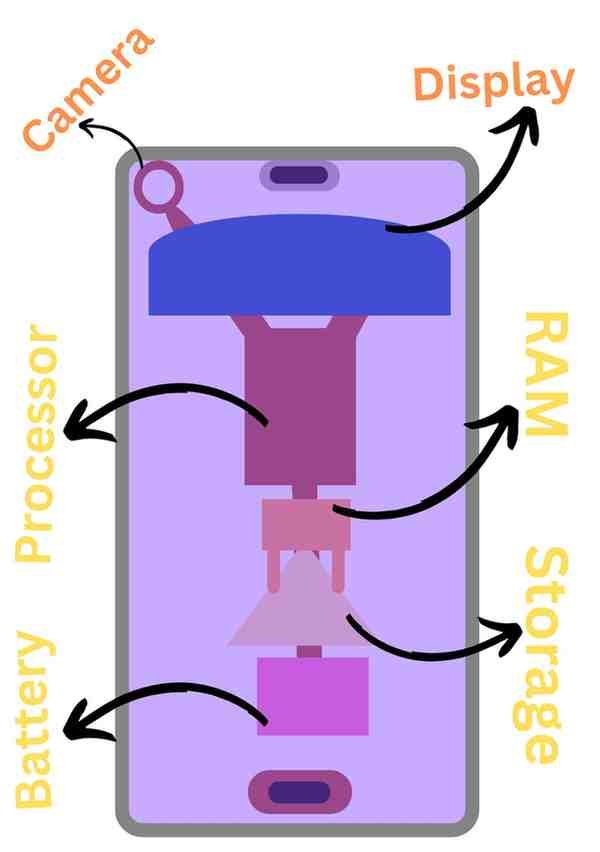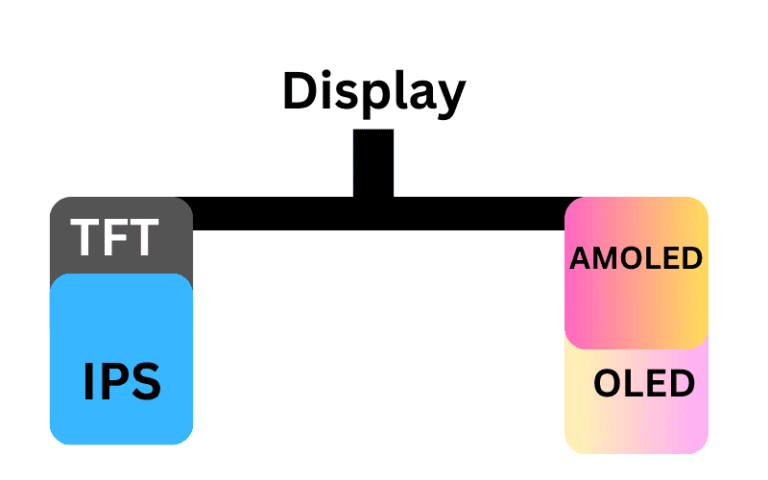Top Cell Phone buying guide: How to choose the Best Smartphone?
“How to Choose the Best Cell Phone” is a prevalent question for every user before buying a new phone in the smartphone era. The market is flooded with cell phones, brands, and types, and appealing marketing can easily mislead buyers. Don’t worry. This guide will help you select the best phone for your needs. We’ve covered every area of mobile phone in detail here. This post confirms how to find the best cell phone for you.

How do I choose the Best cell phone?
The appropriate cell phone may transform your everyday activities by providing access to information, communication, and entertainment. A phone that complements your habits is the ideal option. The appropriate characteristics, such as processor, RAM, and storage, operating system preference, camera quality, battery life, and smooth operation for your favorite apps and games,

PROCESSOR.(how it works?)
A mobile device uses a system-on-chip (SoC), whose professional name is the processor, as its central component. It is responsible for executing tasks and running applications. A mobile device uses a system-on-chip (SoC), which we call a processor, as its central component. It is responsible for executing tasks and running applications. The recent versions of cell phones feature a variety of multi-core processors. The most prevalent configurations are dual-core (two), quad-core (four), and octa-core (eight).
Integration
To ensure smooth performance and compatibility, mobile processors have been optimized to work seamlessly with the device’s operating system (e.g., Android or iOS). A processor integrates various components.
Central Processing Unit (CPU).
To manage multiple tasks simultaneously. The latest CPUs are equipped with multiple cores (for example, dual-core, quad-core, and octa-core).
Graphics Processing Unit (GPU).
GPUs handle graphics rendering and speed up tasks involving image processing, gaming, and multimedia.
Memory Control.
Also responsible for ensuring efficient data management by managing access to system memory (RAM) and storage.
Digital Signal Processor (DSP).
The DSP is responsible for processing audio, image, and sensor data, with a focus on optimizing performance and power efficiency.
Display Control.
The display controller is often built within the device’s CPU and handles the flow of data to the display panel. It converts digital image data into signals that the display can read.
Clock Performance.
A mobile processor’s clock speed, measured in GHz or gigahertz, indicates how many instructions it can execute per second. Clock speed also depends on software optimization and many other things.
Thermal Management.
It plays an important role in preventing overheating and maintaining performance. If processors generate heat during operation, this involves applying techniques such as dynamic voltage and frequency scaling (DVFS), thermal throttling, and heat dissipation mechanisms.
Three brands are mostly famous in the processor industry: Snapdragon, MediaTek, and Exynos. The most popular processor among them was the Snapdragon. Snapdragon dominated the processor industry with good performance for a long time. In 2017, their total market share was over 45%. Then they focus more on flagship smartphones, and other brands take this opportunity. And Snapdragon’s market share declined, which is now down to 24%. No heat issues Snapdragon has built a reputation, but recently their chips have recorded heat issues, specifically the Snapdragon 8 GEN1.
The other brands have taken this opportunity and incorporated more advanced technology. MediaTek is doing remarkable work and coming to the frontline. In addition to the most popular bionic processors, some less popular processors exist, such as the Google Tensor.
Smaller processors will indeed work faster than larger ones. If you knew about the movement of electrons, you would get this point more clearly. Typically, processors are measured in nanometers (nm). The size of the processor chips on the market so far is 12nm, 10nm, 6nm, 5 nm, and 4nm. Respectively. 4NM is the latest version.
If you compare a mobile device to a human body, then the processor is the brain. Let us make it more obvious. Just imagine you are in the office; there is a table, chair, and files. If you are starting work in this field, you are a processor. Nothing is usable without the processor.
RAM (Random Access Memory).
It provides faster access to this data than the device’s internal storage. This speed is required for smooth and responsive performance, whether using apps, multitasking, or browsing the internet. The data is temporary and volatile; it is lost when the device is turned off.
Multitasking: When you transition between programs, the OS saves the previously used app’s data in RAM, making it easier to pick up where you left off when you return to that app. The mobile device’s operating system controls RAM allocation and consumption. It optimizes RAM allocation to different apps and tasks depending on priority and demand, ensuring smooth performance and optimal resource consumption.
Capacity: The RAM size should be selected based on the purpose of use and activity, with a minimum of 8 GB.
DISPLAY.
The display panel is the screen’s physical component, and it is often constructed of glass or plastic. It is composed of millions of tiny pixels that generate light to produce images.
The majority of the market’s displays are LCD- or LED-based. Display technologies include LCD-IPS, OLED, and AMOLED. Each has unique benefits and drawbacks in terms of image quality, power efficiency, and cost.

LCD (liquid crystal display).
LCD operates on a basic premise. It features two panels: a rear backlight and a front liquid crystal panel. It has exceedingly minute liquid crystals. When white light strikes such crystals at different frequencies, a variety of colors appear on the screen. There are two types of LCDs: TFT and IPS.
TFT (thin film transistor) displays are rarely available now. However, among the LCD-based displays, IPS (in-panel switching) displays are more available. It is heavy and thick because of the two panels. But get more brightness and less cost.
LED (light-emitting diode).
There are two types of LED displays available on the smartphones market. OLED (Organic Light-Emitting Diode) display and AMOLED (Active Matrix Organic Light Emitting Diode) display.
OLED (Organic Light-Emitting Diode)
It has multiple emission layers that produce different colors, along with color filters and pixel control capabilities. OLED displays are renowned for their exceptional image quality, which includes deep blacks, high contrast ratios, and broad viewing angles. There are conductive layers, which help transport electrons efficiently from the cathode to the emission layer and vice versa.
AMOLED (Active Matrix Organic Light Emitting Diode)
The latest technology in the display industry. AMOLED pixels emit their light, allowing for precise control over their brightness and color. In AMOLED displays, each pixel is controlled by a thin-film transistor (TFT) in an active matrix. This implies that each pixel can be addressed and controlled independently, resulting in crisper visuals and more efficient power consumption than passive matrix OLED displays.
Display Size
It depends on your preference and activity. If you prefer to watch more videos and movies or play games and feel comfortable, choose the larger display. Resolution and refresh rate are matters of quality display. Of course, you should go with a higher refresh rate and higher resolution (like FHD or Quad HD) with a higher Hz.
STORAGE.
It is a simple concept: the larger the storage, the more useful it is. Although this is only true in terms of capacity, there are many other considerations.
Imagine yourself in a well-organized library, divided into different sections for books, history books, geography, etc. You just pick up the book, put it on the table, and start reading. Here the bookshelf is the storage, the table is the RAM, and you are the processor. However, you are in a disorganized library, and the books are all put together. In this case, there will be a delay in finding the book you want, so your performance will be slower. Cell phones are generally available in two types of storage systems:
a. eMMC (embedded multi-media control) storage.
b.UFS storage (universal flash storage).
eMMC storage.
eMMC is the most common type of storage. It was launched in 1997. It is a very old technology in the mobile phone industry. Not only that, but it works in half-duplex mode. Wondering what half-duplex mode is? Just wait; you will understand it immediately. The data transformation system works in three ways; it is called-
a. Simplex mode.
Simplex mode, almost like unidirectional, can do one thing at a time, either send or receive. And that’s why it works slowly.
b. Duplex Mode:.
Duplex mode is divided into two types, such as:
1.Half-duplex mode. & 2.Full duplex mode.
A half-duplex sender or receiver at a time. We have already described half-duplex mode. But in full duplex mode. Sender and receiver at the same time, so it’s faster.
UFS storage
It is the latest technology compared to EMMC technology. It was launched in 2011. If we talk about smartphones, UFS storage was first used in the Samsung Galaxy S6, and this cell phone was launched in 2014. UFS storage operates in full duplex mode. Also, it supports the command queue feature. The command queue feature means, for example, that you are copying 50 images, but after copying 20, you can cancel if you think you don’t need any more. This means it can follow new commands during operation.
On the other hand, this is not possible in the case of eMMC storage. Also, UFS system can load games faster and scroll faster. Besides, it consumes minimal power and does not heat the mobile. By improving security measures, your personal information will be more secure.
BATTERY.
Of course, batteries are an important part of any chargeable electronic device, especially cell phones. Every user prefers a battery that gives good performance, lasts long, and supports a fast charging facility, even those who have no idea about mobiles.
But, unfortunately, not much information is available in this regard. So how do we choose the perfect battery for a cell phone? Should we choose a higher-capacity battery, meaning more mAh? But the thing is, the 5000 mAh battery charge doesn’t last as long as the 4000 mAh battery in some cases.
Then what should be done?
I will mention some important points in this article so that you can easily understand what type of battery you choose for your mobile so that you can stay tension-free. When you talk about batteries, SOC (System on Chip) inevitably comes up. SOC is commonly known as a processor or CPU. How long the battery lasts depends on how your device’s processor is using the battery.
What is the phenomenon of good battery performance?
Processor: In short, the lower the NM of your mobile processor, the higher the battery efficiency. 6nm processors always get better performance than 10nm processors. If we understand the law of electrons, there will be no more questions about this.
Software: Yes, the software is a fact about battery efficiency. Better software optimization can improve battery life. You can take the iPhone battery as an example because even a 3000 mAh battery performs better than a 4000 mAh Android battery due to its advanced hardware technology.
Display Size: Larger displays always consume more battery. Display grade is also a fact of battery efficiency. LED displays consume less battery power than LCDs. Hence, we always prefer LED displays, such as OLED and AMOLED. You should also think about the display resolution. A higher-resolution display screen consumes more battery power.
Cooling System: If your device heats up, it will naturally consume more battery because the cooling system has to work harder. So, a good cooling system is good for battery health. Local temperature affects battery life in some way. If you live in a hot climate where the temperature is high and your mobile is exposed to strong sunlight, it can also affect the battery. Because in this case, the display of the device should be at high brightness.
Fast Charging: It is a very common theory that if the battery is charged fast, it will drain faster. So keep a balance between battery capacity, charging, and device usage if you want the best output. We recommended a minimum 5000-mah capacity.
CAMERA.
Most cell phones now offer a variety of camera configurations, including dual, triple, and quad cameras. Dual camera systems are common, having a regular lens plus a secondary lens (such as telephoto or wide-angle). A triple camera arrangement often has three lenses: a primary lens, a wide-angle lens, and a telephoto or depth sensor. A quad camera setup consists of four lenses: a primary lens, an ultra-wide lens, a telephoto lens, and a depth sensor or macro lens.
Cell phone models and brands may have varying lens counts and combinations. Some high-end smartphones may have more than four lenses for specialized applications such as greater zoom, macro photography, or depth sensing.
If you love photography or are a content maker, you want to buy a mobile with the best camera. The reality is that more megapixel cameras alone don’t make for better photos. The best mobile camera for photography and videography is determined by several criteria, including device hardware, software optimization, and personal preferences. However, in general, cell phones with the following qualities tend to excel in photography and videography:
High Megapixel, Large Sensor Size, Optical Image Stabilization (OIS), Advanced Autofocus System, Advanced Camera Features, Pro Mode or Manual Controls, High-Quality Lenses, and 4K Video Recording. It would help to examine your specific demands and tastes when deciding on the best mobile camera for photography and filmmaking. We recommend telephoto lenses or periscope lenses, which allow for larger zoom ratios. You can see the user experience.
Wireless Connection .
Cashless transactions are one of the benefits of the digital age. The NFC takes this advantage a step further. If you want to enjoy this benefit like everyone else, make sure your cell phone has an NFC feature. An uninterrupted connection can only facilitate seamless browsing. In this case, a better WiFi connection and higher speed are desirable.
Before buying the cell phone, ensure it supports at least WiFi 5. Bluetooth connections play a unique role in fast file and data transfers. You also need to be aware of this. We recommend at least Bluetooth 5.
Perfection:
Android and iOS are the two major operating systems in the cell phone industry. Android has numerous customization possibilities and is compatible with various devices. On the other hand, iOS provides a consistent user experience with limited options; it prioritizes security and privacy.
Cell phones have transformed the way people communicate and obtain information. These modern mobile devices have become an essential part of our daily lives, with a diverse set of features and capacities.
Consider your needs and how you will use it daily. Understanding your usage habits will assist you in selecting the best cell phone and determining the features and services you require from your cell phone.
There are various prices for mobile phones available on the market; it depends on features, quality, and brand. Determine how much you will spend according to your budget and requirements.







voluptatem magnam et consequatur enim qui ipsa labore natus eligendi illum quia voluptate. at facere cumque sequi corrupti nostrum cumque occaecati ad nostrum quaerat at. nihil similique aut doloribus
ullam possimus ipsam sint molestiae repellendus et esse libero id sit harum dolorum saepe molestiae rerum. aliquid incidunt cumque eligendi rerum omnis velit architecto optio in non placeat voluptas a
accusamus doloribus odio cumque quo dolorem at tempore sed est eos rerum tempore. nemo eveniet eum praesentium ut quo necessitatibus asperiores ut repellendus explicabo modi ipsam ducimus quisquam.
consequatur nobis tempora vero nostrum eum saepe et nobis vel quia harum culpa tenetur ea. non nihil ut laboriosam repudiandae earum dolorum ut est nihil dolorum quod soluta earum culpa aut vel qui. n
Today, I went to the beachfront with my children. I found a sea shell and gave it to my 4 year old daughter and said “You can hear the ocean if you put this to your ear.” She placed the shell to her ear and screamed. There was a hermit crab inside and it pinched her ear. She never wants to go back! LoL I know this is completely off topic but I had to tell someone!